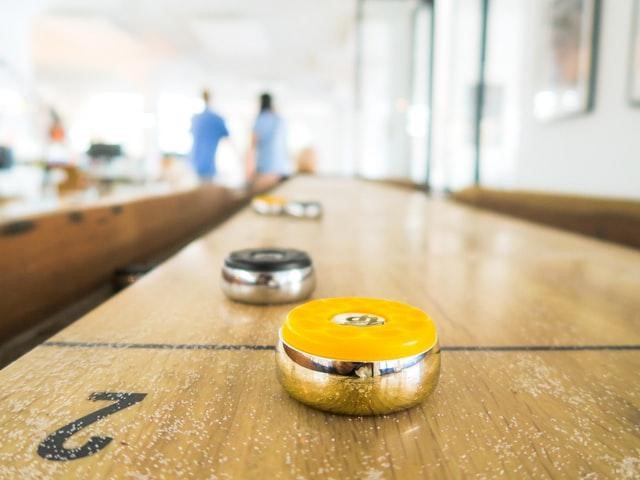The game of shuffleboard had its start roughly in the 1400s in England, that is the belief. The game at that time was referenced as “Shoffe-Groat.” The premise was a “groat” or coin of 4 pence would be slid down a table to score points depending on how close it came to the edge without going off.
The King at the time (Henry VIII) was an avid player but outlawed the game for the “common” folks indicating it was a distraction from the tasks that needed completing. Learn details about shuffleboard at https://mybackyardsports.com/uncategorized/5-things-to-know-about-shuffleboard/
With the current game, a smooth wooden table is used with weight pucks slid down to an area where there are areas marked for designated scored points. The table’s length is “officially” 22′ long with a width of 20.” In an unofficial capacity, there is a range of measurements with the width standard.
The top and bottom of the board are designated by scoring areas covering the table’s width. There are three areas labeled “1”, “2,” and “3,” denoting the number of points scored when landing in those areas. There are a few factors to consider when deciding to add this game to your home rec room. Let’s look at a few tips.
What Tips Should You Consider When Buying Shuffleboards
When investing in equipment for a rec room, you want to ensure the materials are quality and the product is optimum. When shopping, Watson’s best shuffleboards are an excellent place to start for durable, stable, and well-built tables.
If you ignore standards, subpar materials can affect the game, particularly the speed of the pucks sliding down the board. Something to be mindful of, when the product specifies indoor use, it should be kept inside.
It won’t be appropriate, nor will it be able to withstand the conditions or abuses from the outdoors.
● Shuffleboard size should be appropriate to the room size
Shuffleboard tables can range in size, but it’s crucial to look for the appropriate one for your specific room dimensions. The recommendation is that there be 3 feet of clearance on all sides of the table after placement in the space. That means you shouldn’t try to put too large of a table in an undersized room.
The official size for the table is 22 feet long, but these come in compacted varieties to as low as 9 feet, but the width is standard. The traditional table comes with a thickness of three inches. That gives players a durable surface for play and allows the potential for sanding if there’s a need for refurbishing.
● The wood finish has changed over time
The wood species typically used for the tables is maple. At one point in time, a hard wood species was used, but over time the industry has settled on a softer Canadian option instead.
They’re able to do this because the finish coat is much more durable than the lacquers of the old days. Polymer offers a much smoother surface plus protects the wood from potential scuffing or dents.
Other wood species that can be used are birch, mahogany, and oak, along with maple; these constitute the best choices for shuffleboard tables. The durability is critical, aside from the smoothness for sliding the puck.
There is often exposure to damage when heavy pucks are dropped on the surface, and other abuses are experienced.
When done right, a shuffleboard table has longevity with its lifespan. It’s possible to see a table endure a 50-year or more life cycle. That’s incredible for a piece of furniture, especially one that has been used extensively, voraciously, and especially competitively.
● The scoring system comes in two styles
You’ll notice there are shuffleboard tables with two varied scoring grids. The “1, 2, 3” points system is the most common for indoor shuffleboard tables.
There is also a triangular scoring section. These are often seen on outdoor tables. It features a triangle that offers six areas with varied scoring possibilities.
Again, you want to make sure to keep the indoor boards for use on the inside only. Outdoor shuffleboards are exceptionally durable, making them capable of withstanding more abuse and common conditions associated with the outside.
Final Thought
You can purchase the “official” regulation board if you have room for it in your rec area and want to experience the authentic game version. But there are variations of the lengths down to as short as 9 feet for homes that can’t accommodate the full size.
You can even DIY a board to create a custom version. See here a guide on DIY for a shuffleboard table. While the 9-foot-long and other sizes might not give you the whole experience of the regulation board, you still get the effect of shuffleboard. It’s still a great time; you won’t find a dissatisfied player in the house.



